One of the most exciting aspects of being involved with cryptocurrency is exploring cutting-edge technology and innovation within the top cryptocurrency networks and investigating topics like the top NEAR protocol projects.
The NEAR ecosystem is a budding and rapidly expanding space, and today, we will be looking at the Top 5 Near protocol projects and providing some background information.
Before cracking on and exploring the top NEAR projects, let's give you a quick overview of the NEAR Protocol.
NEAR Protocol Overview
NEAR is a layer-1 blockchain platform that supports smart contracts and focuses on usability, speed, and low-cost transactions
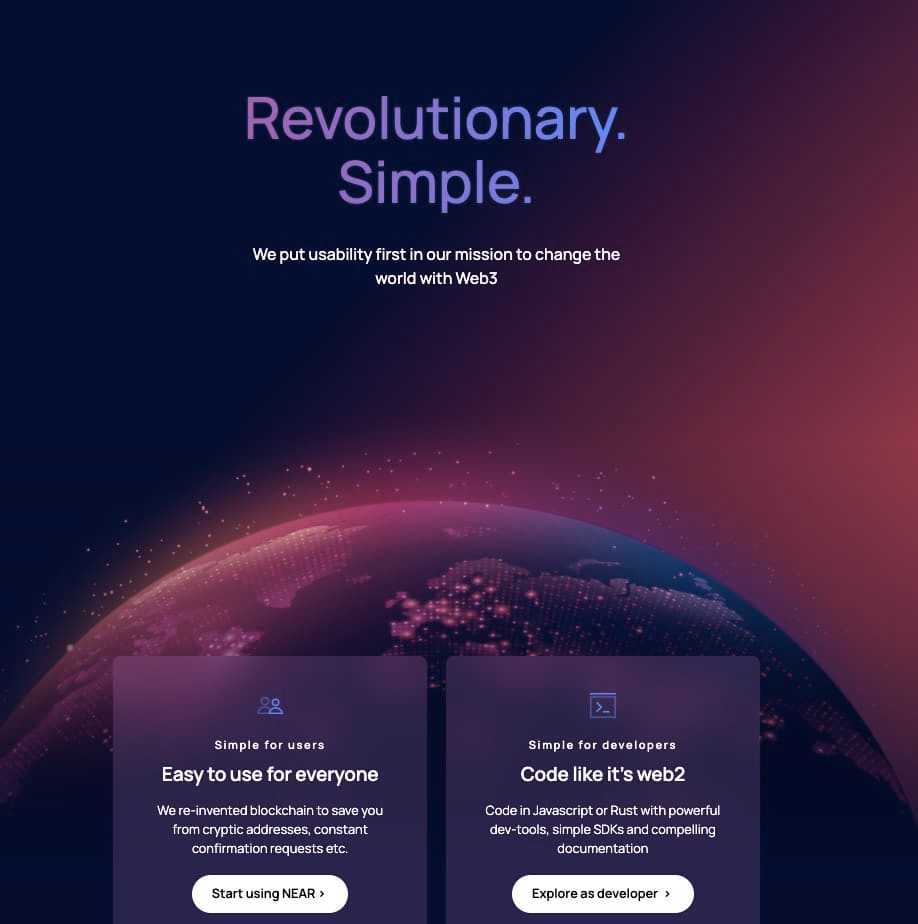
Here are its key characteristics:
- Threshold Proof of Stake (TPoS): NEAR’s TPoS consensus mechanism elects a set of nodes (rather than a single node like in PoS) to make consensus decisions. The mechanism ensures network security and decentralization.
Validators stake a certain threshold of NEAR tokens to participate in block validation, ensuring that smaller validators can participate without requiring large stakes. - Nightshade: It is Near’s unique sharding mechanism. Nightshade enables the network to scale efficiently by splitting data processing across multiple shards. Unlike traditional sharding, Nightshade ensures that the entire network continues to operate as one cohesive blockchain while each shard handles its own smaller batch of transactions. Nightshade improves throughput without sharding-induced centralization.
- The NEAR Foundation: It is pivotal in steering the ecosystem, offering funding and support to developers, businesses, and communities building on NEAR. The foundation aims to accelerate the adoption of decentralized applications (DApps) by promoting projects that expand NEAR's use cases and reach.
- Aurora Layer 2: An EVM-compatible blockchain operating as a layer 2 on the NEAR protocol. Its primary utility is as a bridge to Ethereum, allowing developers to deploy Ethereum-compatible smart contracts on NEAR at a lower cost and faster speed.
- Octopus Network: An appchain network runs as a smart contract on the NEAR network. Octopus provides infrastructure support (security, interoperability, governance, etc) to projects looking to launch specific appchains for their web applications.
If you'd like a deeper look into this ecosystem, refer to the NEAR Review on the Coin Bureau.
NEAR Protocol in Recent History
In 2024, NEAR shifted its primary focus from promoting a highly scalable and secure blockchain network to promoting chain abstraction and account abstraction to onboard more users into the Web3 ecosystem by simplifying the user experience.
Chain abstraction is when a DApp is compatible with any chain, and the user is not required to ensure that they operate on a specific chain. It involves enabling DApp users from different networks to interact seamlessly with one another. Account abstraction is when the user needs just one on-chain account to access multiple networks.
Together, chain and account abstraction will let users interact with DApps in any network (say Ethereum, NEAR, Polygon, Cosmos), and an account abstraction framework will maintain their addresses across different networks in the backend.
How is NEAR promoting these initiatives:
- Developing NEAR Data Availability layer to enable DA for Ethereum. The premise is to have applications use NEAR DA instead of Ethereum's DA layer for faster throughput and cheaper DA fees.
- NEAR Super Fast Finality Layer (SFFL): NEAR is partnering with EigenLayer to develop SFFL for Ethereum rollups. SFFL is a collaboration that will have NEAR full nodes serve AVS (Actively Validated Services) on EigenLayer, creating a dual-quorum DA layer. Rollups that leverage this DA layer will benefit from the security guarantees of both the EigenLayer and NEAR protocol.
Top NEAR Projects
The NEAR DApp ecosystem has experienced rapid growth, with new projects and milestones emerging since our last deep dive into the space. Before we go into that, here's a neat table that includes essential information of each DApp mentioned in this article.
| DApp | Catergory | Description | Token Utility |
|---|---|---|---|
| Sweat Economy | Move-to-Earn | Rewards users with SWEAT tokens for physical activity, bridging Web2 and Web3 through blockchain-based fitness rewards | Earned by users for physical activity, used for rewards, shopping, staking, and governance |
| Burrow | DeFi Lending/Borrowing | A decentralized lending and borrowing platform allowing users to earn interest on deposits or use them as collateral | Native token (BRRR) used for governance and staking in vote-escrow contracts |
| Ref Finance | DeFi Platform | A multi-purpose DeFi platform offering token trading, liquidity pooling, yield farming, staking, and lending & borrowing | Native token (REF) serves as both governance and utility token for staking, liquidity, and protocol upgrades. |
| Orderly Network | Liquidity Layer | A decentralized liquidity layer offering order book-based trading infrastructure for deep liquidity on NEAR | Native token ($ORDER) used for governance, staking rewards, and trading incentives |
| Allstake | Staking/Restaking | Multi-chain staking and restaking protocol for users to stake assets across multiple ecosystems securely | Supports validators in NEAR’s proof-of-stake system, offering staking rewards |
| MITTE Marketplace | NFT Marketplace | Leading NFT marketplace optimized for mobile use, supporting bulk NFT trading on the NEAR Protocol | Facilitates NFT trading, enhances liquidity, and visibility for NFT projects |
| Meta Pool | Liquid Staking | A liquid staking platform that allows users to stake assets like NEAR while maintaining liquidity through liquid tokens | Allows users to stake assets and receive liquid tokens usable across DeFi platforms |
| PlayEmber | Web3 Gaming | A Web3 game studio providing play-to-earn mechanics | Introduces play-to-earn elements and an NFT collection (Emby) to enhance gameplay |
With that out of the way, here's more detailed information on each DApp.
Sweat Economy (SWEAT)
Sweat Economy is a move-to-earn decentralized application (DApp) built on the NEAR blockchain. It encourages physical activity by rewarding users with SWEAT tokens for their steps and other forms of movement, making it a unique fusion of fitness and blockchain technology. Originally launched as the Web2 application Sweatcoin, it transitioned to Web3 by introducing the SWEAT token, designed to create an "economy of movement" where users can earn by simply staying active.
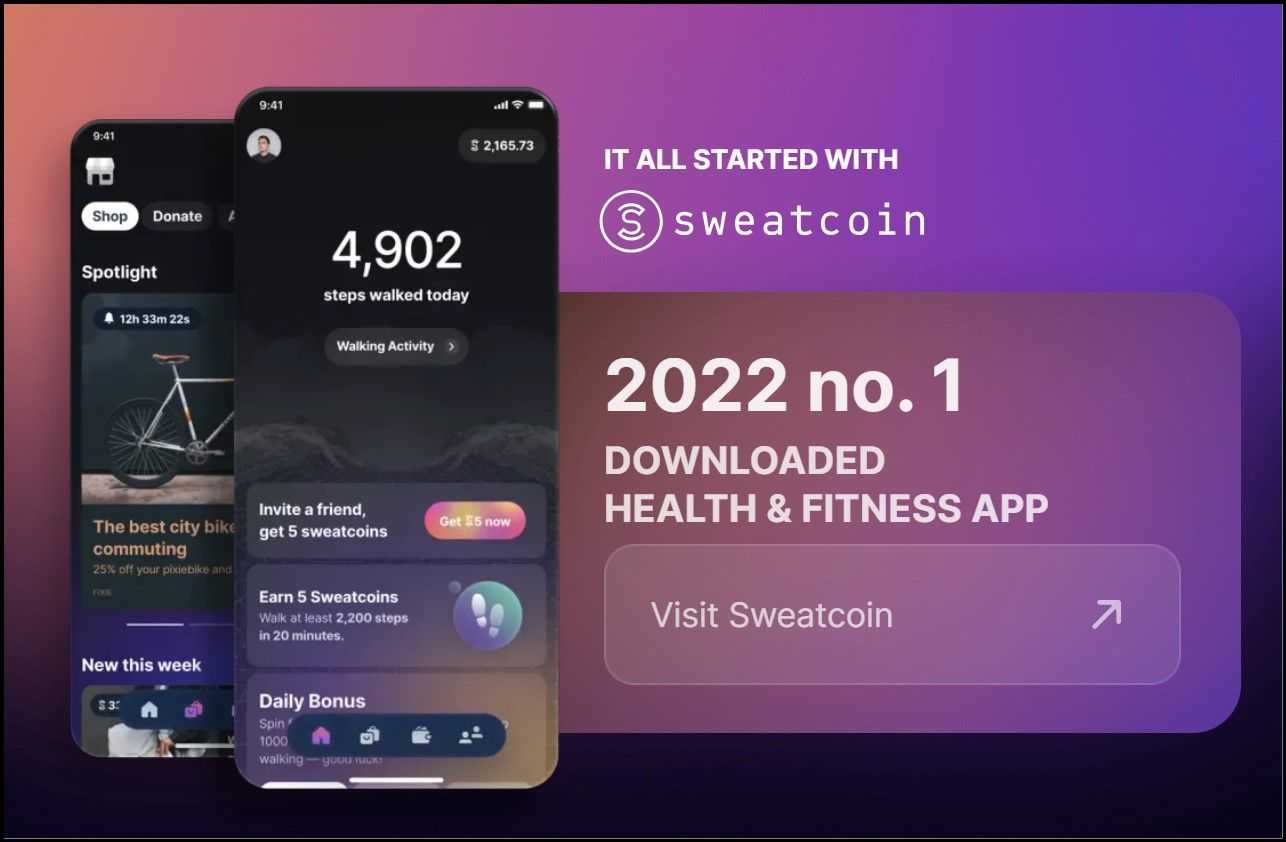
Sweat's Utility in the NEAR Ecosystem
Sweat Economy taps into NEAR’s scalability and low transaction fees, enabling a seamless experience for millions of users. By validating steps and other physical activities, SWEAT helps users engage with the NEAR ecosystem while incentivizing healthy lifestyles. It bridges the gap between Web2 and Web3, helping to onboard new users into the NEAR ecosystem while expanding the utility of blockchain technology to everyday fitness activities.
Token Utility
SWEAT tokens serve several purposes within the Sweat Economy ecosystem:
- Rewards: Users earn SWEAT tokens for their physical activity, with steps tracked and validated through the Sweatcoin app.
- Shopping and Bidding: SWEAT tokens can be used to purchase vouchers for brands like Amazon, Netflix, and Adidas or to participate in auctions for various goods.
- Staking: Users can stake their SWEAT tokens to earn more rewards and increase their daily movement earning limits.
- Governance: SWEAT token holders can participate in governance decisions, influencing the direction of the Sweat Economy.
Milestones
Since its launch, Sweat Economy has achieved several key milestones:
- Token Generation Event: In September 2022, Sweat Economy launched the SWEAT token, expanding its move-to-earn model to the NEAR blockchain. This marked its official transition from Web2 to Web3.
- Large User Base: Sweat Economy boasts over 140 million users globally, positioning it as one of the most widely adopted fitness-related DApps.
- Expansion of Movement Activities: Initially, SWEAT could only be earned through walking. However, the app plans to integrate more forms of physical activity, including swimming, cycling, and gym workouts, to further broaden its reach.
You can read our Sweatcoin review to know more.
Burrow
Burrow is a decentralized lending and borrowing platform built on the NEAR Protocol. Like popular decentralized finance (DeFi) platforms like Aave and Compound, Burrow allows users to deposit assets to earn interest or use them as collateral to borrow other assets. Its primary goal is to offer a non-custodial, DeFi experience for users looking for finance in the NEAR ecosystem.
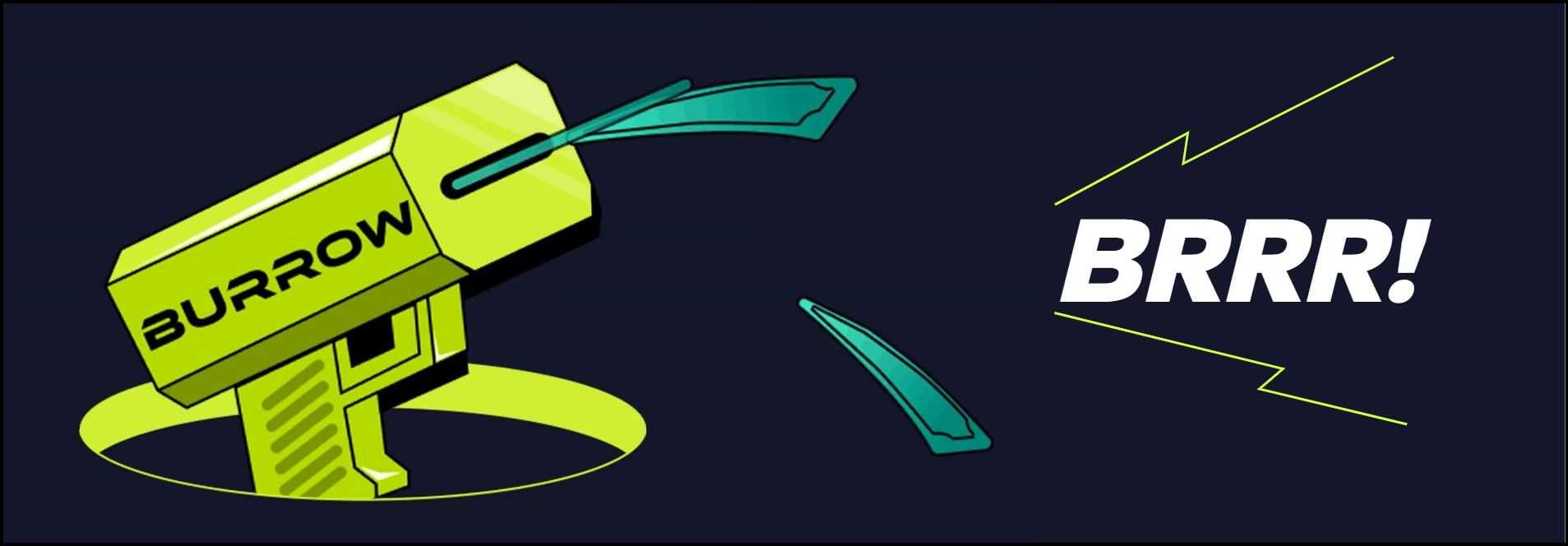
Burrow's Utility in the NEAR Ecosystem
As part of NEAR’s growing DeFi ecosystem, Burrow significantly enhances liquidity and accessibility to decentralized finance on NEAR. It enables users to earn interest on deposits or access liquidity without selling their assets. This makes it especially appealing for those who want to maintain exposure to long-term crypto holdings while still accessing funds in the short term. Burrow’s seamless integration with NEAR's infrastructure allows for minimal-cost transactions, positioning it as a critical player in NEAR’s DeFi landscape.
Token Utility
BRRR is Burrow's native token and is used in DApps governance. Burrow follows a vote-escrowed governance system similar to the CurveDAO. BRRR token holders must stake their tokens in the vote-escrow contract to receive xBRRR, which is used in DAO governance. Holders earn more tokens the longer they stake.
Milestones
Since its launch, Burrow has become the leading protocol in the NEAR ecosystem. One of its notable achievements is its growing Total Value Locked (TVL), which signals increasing trust and participation from the DeFi community. With the current TVL at $155.83 million based on DappRadar, Burrow remains the leading lending platform by a significant margin.
Ref Finance
Ref Finance is a multi-purpose DeFi platform built on the NEAR Protocol, utilizing WebAssembly and supporting smart contracts written in Rust. It offers a comprehensive set of decentralized financial services, including token trading, liquidity pooling, yield farming, staking, and lending & borrowing. These services are designed to facilitate easy and efficient use of DeFi on NEAR, making Ref Finance a cornerstone for decentralized financial operations in the NEAR ecosystem.
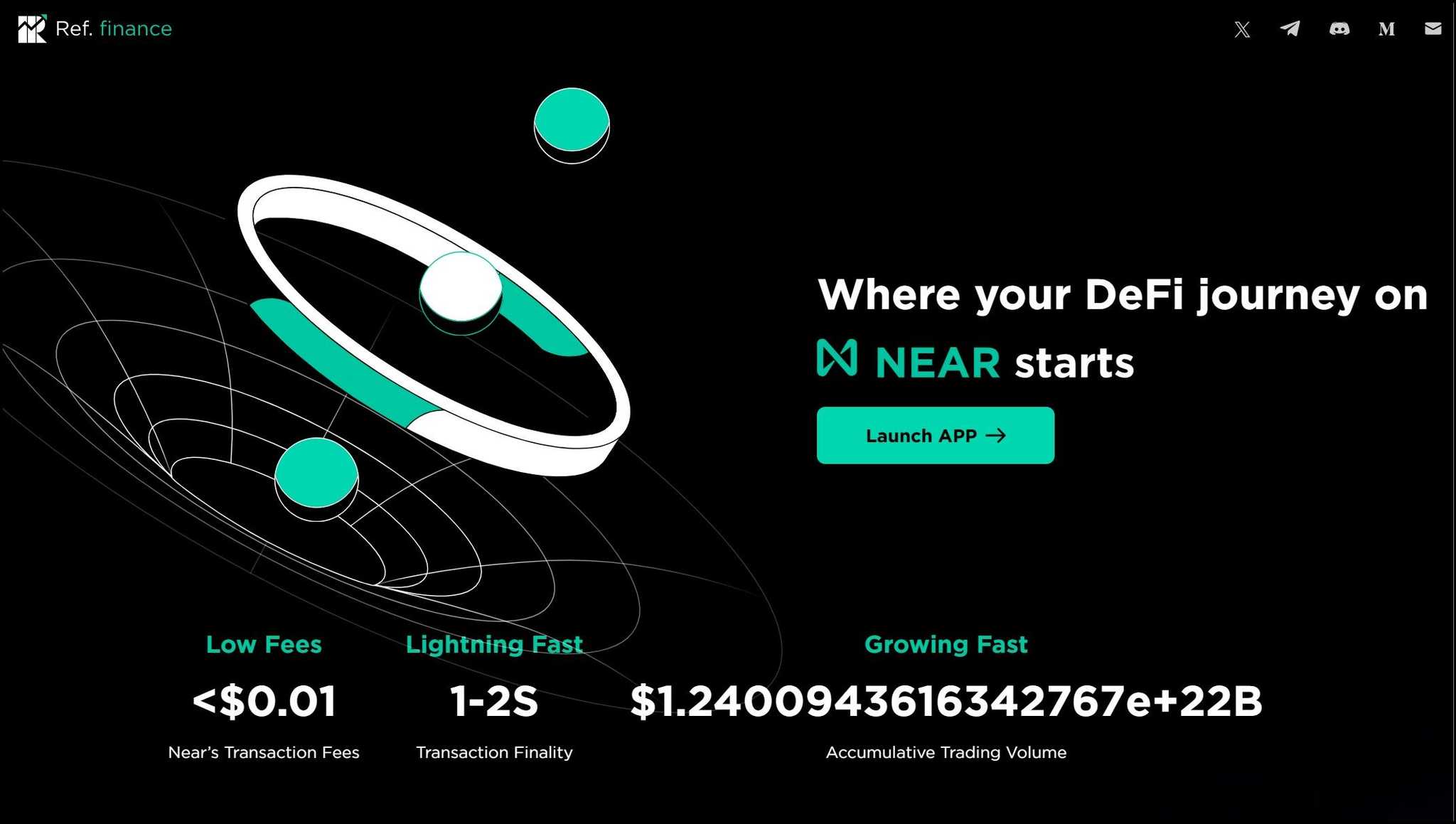
Features:
- Trade: Users can swap tokens using Ref’s Automated Market Maker (AMM) system, which optimizes trading routes to ensure efficient and low-cost transactions.
- Pool: Liquidity providers can pool assets and earn rewards, supporting the protocol's functionality by enhancing market liquidity.
- Farm: Ref allows users to stake their liquidity provider (LP) tokens in yield farms, earning additional rewards over time.
- Stake: REF token holders can stake their tokens to participate in governance and earn a portion of protocol fees.
- Lend & Borrow: Users can also lend their assets to earn interest or borrow against their collateral, expanding the financial flexibility of the platform.
The REF Token
The native token, REF, is pivotal in Ref Finance’s ecosystem. It serves as both a governance and utility token. By staking REF, holders can vote on protocol upgrades and proposals, participate in governance decisions, and earn a share of the protocol's revenue. Additionally, REF tokens can provide liquidity and stake LP tokens in yield farming.
- Tokenomics:
- Total supply: 100,000,000 REF
- Allocation: A significant portion of tokens (60%) is set aside for liquidity incentives, while 20% is held in the treasury.
Milestones
Ref Finance is the leading decentralized exchange (DEX) in the NEAR ecosystem, with a significant share of total value locked (TVL) and trading volume. It has also integrated with the Rainbow Bridge, enhancing cross-chain interactions with Ethereum, and has introduced Ref V2 pools for more efficient liquidity management.
Orderly Network
Orderly Network is a decentralized liquidity layer built for Web3 trading, offering advanced order book-based trading infrastructure. Built on NEAR, it supports deep liquidity for both spot and perpetual trading across multiple networks. The platform's architecture combines DeFi principles with centralized exchange (CEX)-like performance, ensuring efficient trade execution while maintaining self-custody.
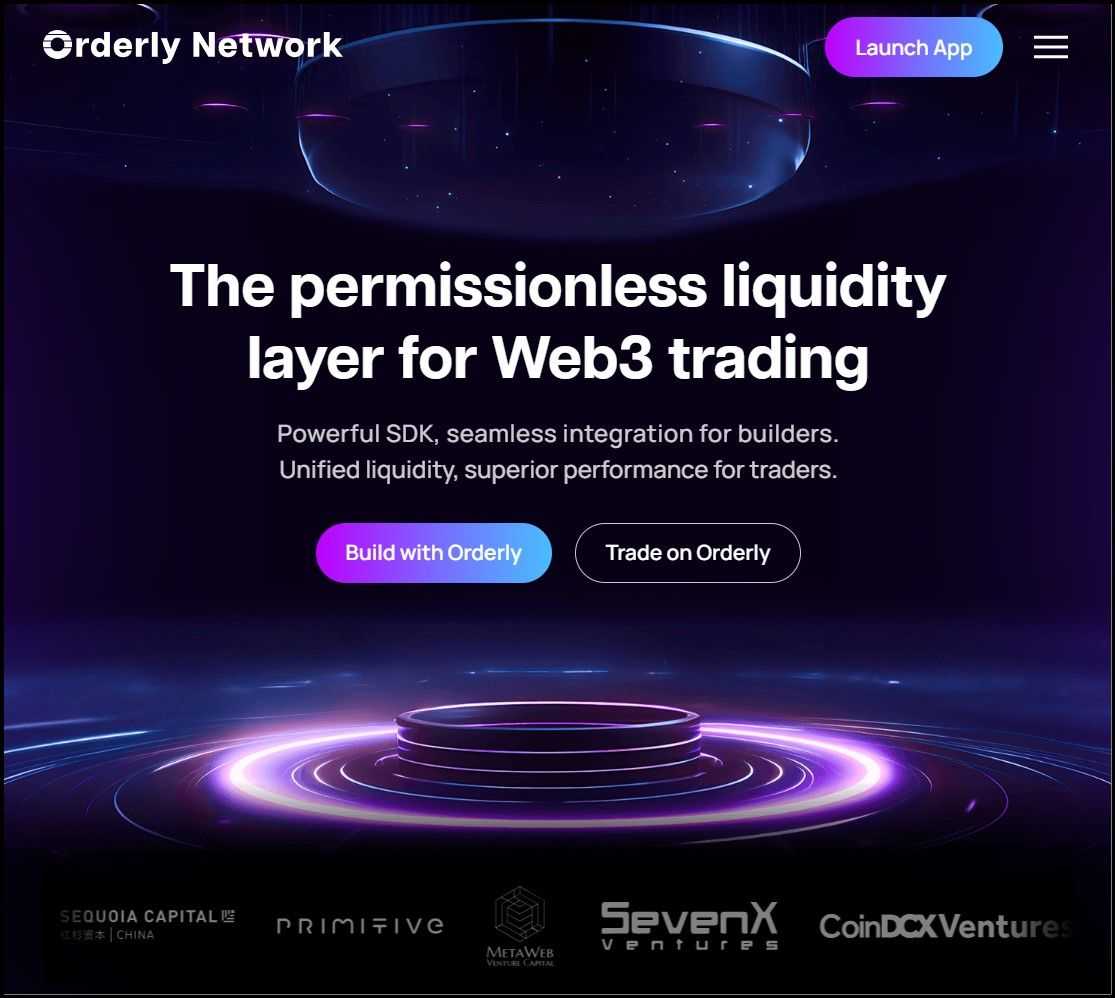
Orderly offers a range of services:
- Brokerage: Create new Spot or Perp DEXs
- Aggregators: Access the protocol liquidity across all integration spot and perp markets, securing the best rate for trades.
- UX: CEX-like under experience.
- In-app Widgets: Access orderly’s liquidity with in-app widgets to reduce UX friction.
Other features include gasless trading, cross-chain capabilities, and smart contract trading support. Developers can build decentralized applications (DApps) and trading platforms leveraging Orderly’s SDKs and APIs.
The ORDER Token
Orderly's native token, $ORDER, is central to the platform's ecosystem. The token serves multiple purposes:
- Governance: Holders can vote on the protocol's future developments.
- Staking: By staking $ORDER, users receive VALOR, which determines their share of the protocol's rewards and treasury.
- Trading and Market-Making Incentives: Traders and liquidity providers can boost their rewards by staking $ORDER.
The token has a total supply of 1 billion, with a significant portion allocated to community rewards, investors, and the ecosystem’s growth.
Milestones
Orderly Network has crossed significant milestones:
- In Q3 of 2024, Orderly reported $80 billion in total trading volume and more than 290,000 unique wallets.
- The platform has also been deployed across six major blockchain networks and has secured over $50 million in total value locked (TVL).
- Key partnerships with players like Google Cloud and LayerZero reinforce its position in the DeFi ecosystem.
Allstake
Allstake is a multi-chain staking and restaking protocol on NEAR. The application lets users natively stake or restake assets in ecosystems like NEAR, Bitcoin, Ethereum, Solana, or Ton. The platform is designed to simplify, offering a seamless experience for users who want to earn passive income through staking without complex management.
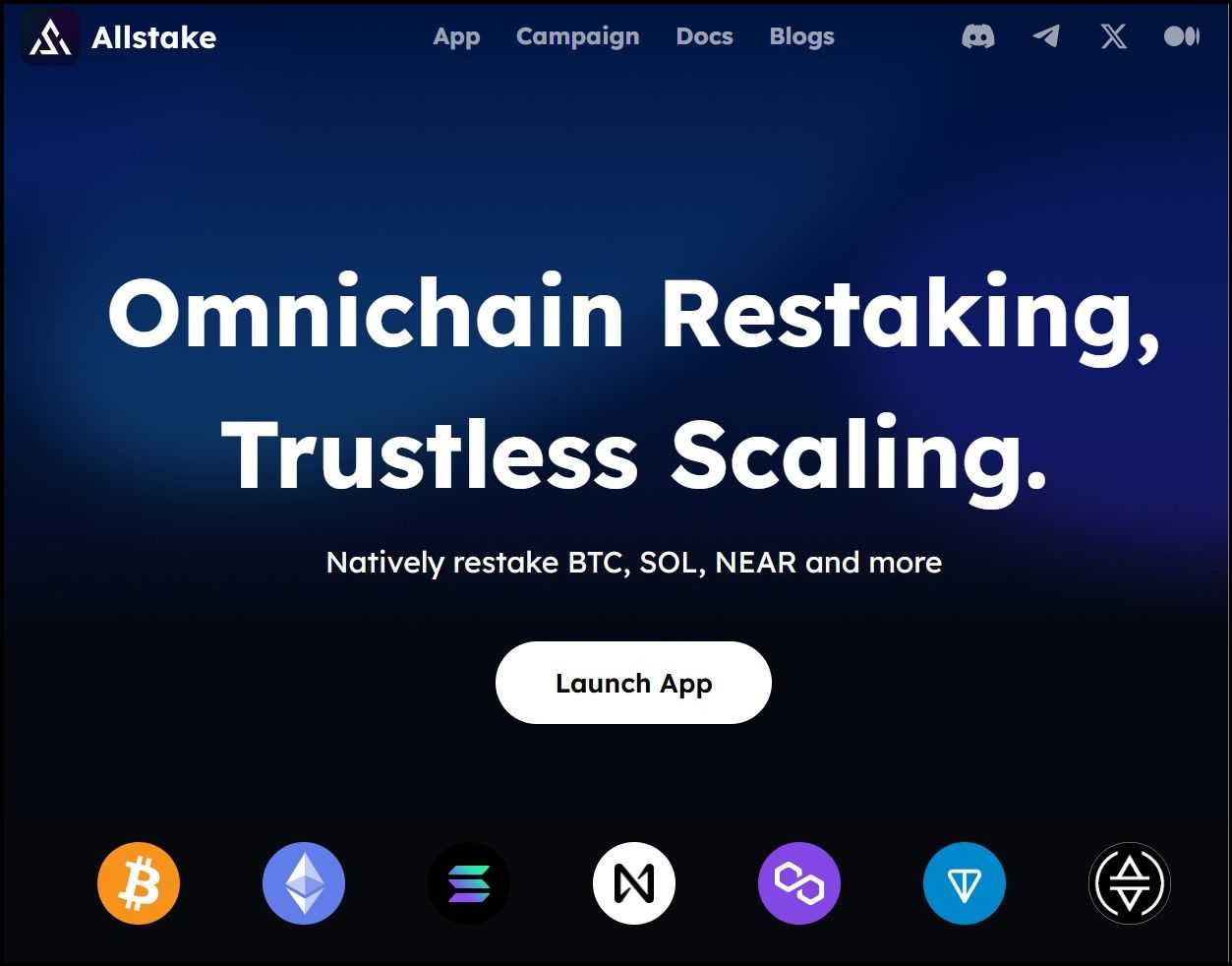
Allstake's Utility in the NEAR Ecosystem
Allstake enables users to stake NEAR tokens securely. The platform supports validators within NEAR’s proof-of-stake (PoS) system, ensuring network security while rewarding stakers. Allstake’s user-friendly interface and integration with NEAR make it an accessible choice for those looking to contribute to the network’s validation process without needing deep technical expertise.
Allstake Features
- Point system: Depositors receive one point per value in 1$ staked per hour. GEMs are another point system earned by participating in community initiatives.
- Meshed staking/restaking: Users can stake a combination of on-chain assets without needing a bridge.
- Native staking/restaking: Allstake does not use a restaking hub and stakes tokens on-chain natively.
Milestones
Since its launch on June 20, Allstake has grown in usage within the NEAR ecosystem, gathering $15 million in TVL (based on October DappRadar data) and securing the fourth place in NEAR DApps locked value.
MITTE Marketplace
MITTE is the leading NFT marketplace on NEAR Protocol, optimized for mobile use and designed to facilitate easy and quick NFT trading. It operates with an order book model, similar to centralized exchanges, allowing users to trade up to 50 NFTs simultaneously. This bulk trading feature makes it a strategic choice for NFT investors looking to trade in large volumes.
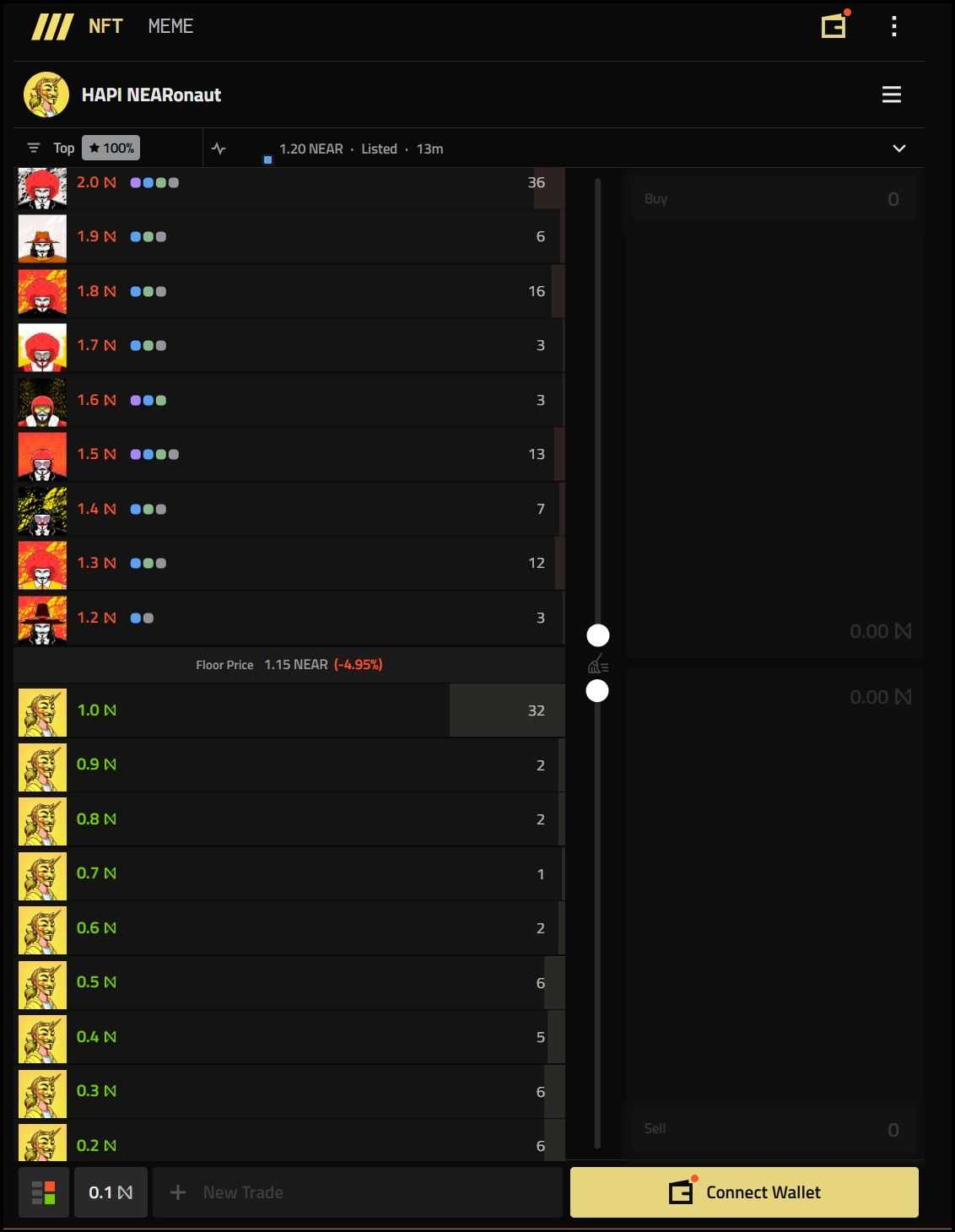
MITTE's Utility in the NEAR Ecosystem
Since its launch, MITTE has emerged as the dominant platform for NFT trading within the NEAR ecosystem, processing over 90% of NEAR's NFT trading volume. Its mobile-first approach, combined with a simplified trading experience, has drawn a substantial user base. By enhancing liquidity and visibility for NFT projects on NEAR, MITTE has significantly contributed to the ecosystem's growth.
Milestones
MITTE experienced a notable surge in activity in early 2024, culminating in a record daily sales volume of $650,000 on May 1, 2024. This spike marked a yearly high for NFT activity on the NEAR Protocol, further solidifying MITTE’s position as the go-to platform for NFT trading.
Meta Pool
Meta Pool is a liquid staking platform built on the NEAR Protocol, allowing users to stake assets like NEAR, Ethereum, and Solana while receiving liquid staking tokens (such as stNEAR) in return. These tokens can be used across various DeFi platforms, enabling users to earn staking rewards while maintaining liquidity. Meta Pool simplifies the staking process and enhances capital efficiency by unlocking liquidity for staked assets.
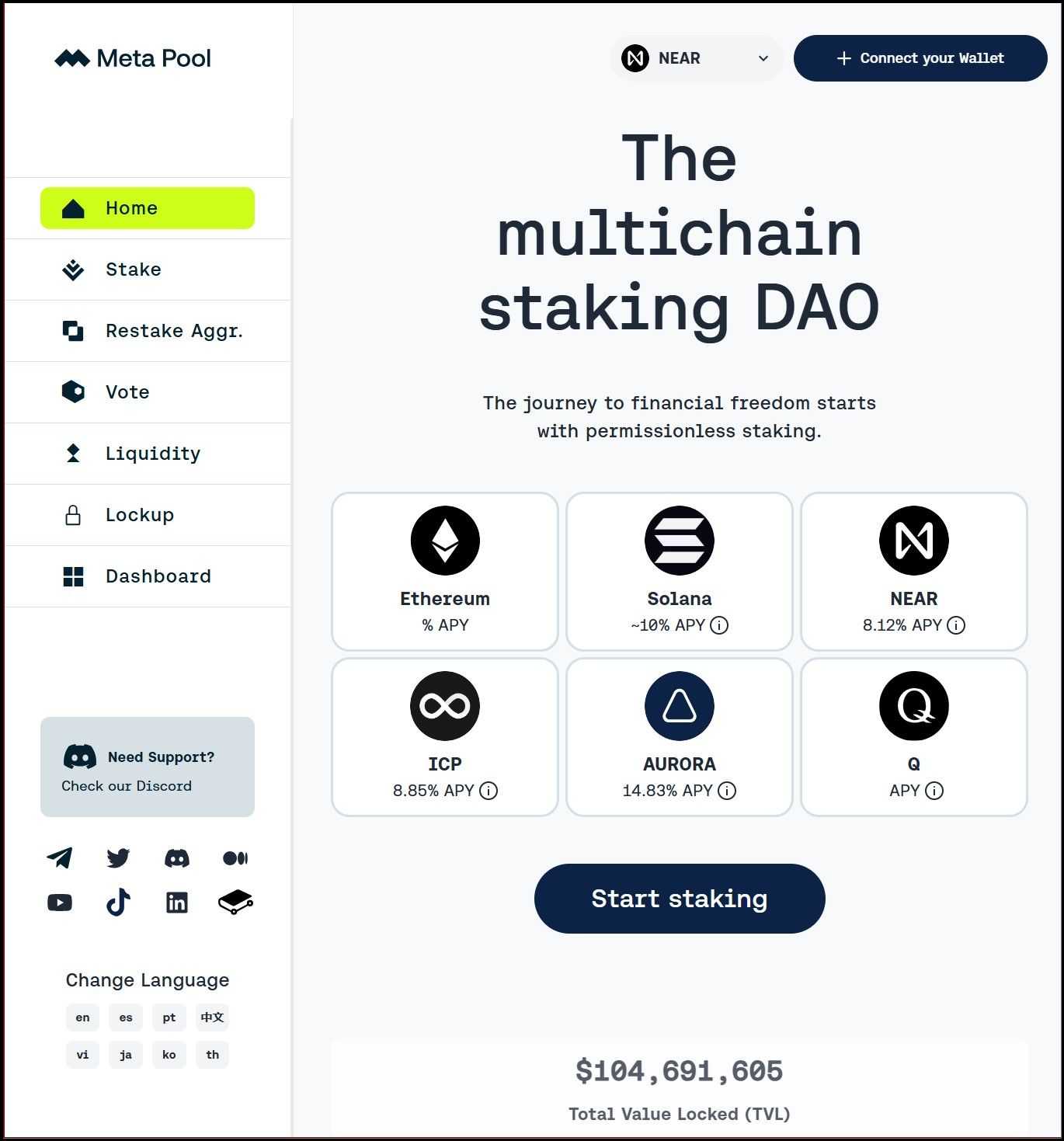
The application offers the following features:
Multi-chain Liquid Staking
Meta Pool offers multi-chain liquid staking for assets such as NEAR, Ethereum, and Solana. Users can stake assets across different chains while receiving liquid staking tokens (e.g., stNEAR) that can be used in DeFi applications. This feature enhances interoperability and broadens access to staking opportunities across multiple blockchain ecosystems.
Institutional Liquid Staking
This feature caters to institutional investors by providing tailored staking services with enhanced security and liquidity management. It offers large-scale staking solutions, enabling institutions to stake significant assets while maintaining liquidity to participate in DeFi markets.
Crowdfunding Launchpad
Meta Pool's Crowdfunding Launchpad allows projects to raise funds from the community through token sales. Users can participate in early-stage investments using their staked assets, further integrating staking with decentralized fundraising initiatives.
Bond Marketplace
Meta Pool's Bond Marketplace enables users to buy and sell staking bonds, a financial product designed to lock in future staking rewards. This marketplace adds liquidity to staked assets by creating tradable staking bonds, allowing users to flexibly manage their staking positions.
Vote & Governance DAO
Meta Pool operates through a decentralized governance model where token holders can vote on key decisions and protocol updates. The Vote to Earn system rewards participants who engage in governance, aligning the community's interests and fostering decentralized decision-making.
Milestones
In 2024, Meta Pool has reached significant milestones, including supporting multi-chain governance and liquid staking for additional assets like Solana. Notably, it distributed over $220,000 in liquid staking tokens through its decentralized governance and grant programs, making it one of the top DAOs in the NEAR ecosystem.
PlayEmber
PlayEmber is a leading mobile Web3 game studio with over 120 million downloads and 5 million active monthly players. The company develops and publishes Web3 games, helping traditional Web2 gamers transition seamlessly into Web3 ecosystems. PlayEmber also supports external studios and intellectual properties (IPs) with their game development and monetization strategies. They focus on casual mobile games, a genre they’ve mastered with popular titles such as Hyper Cards, Raft Life, and Superhero Race.
PlayEmber's Utility in the NEAR Ecosystem
PlayEmber has integrated its Web3 capabilities with the NEAR Protocol, utilizing blockchain to offer players play-to-earn mechanics, without the friction of traditional Web3 games. Their NEAR-based wallet integration and monetization platform have simplified the user experience, making it easier for casual players to engage with crypto elements such as NFTs and in-game rewards.
PlayEmber Tokens
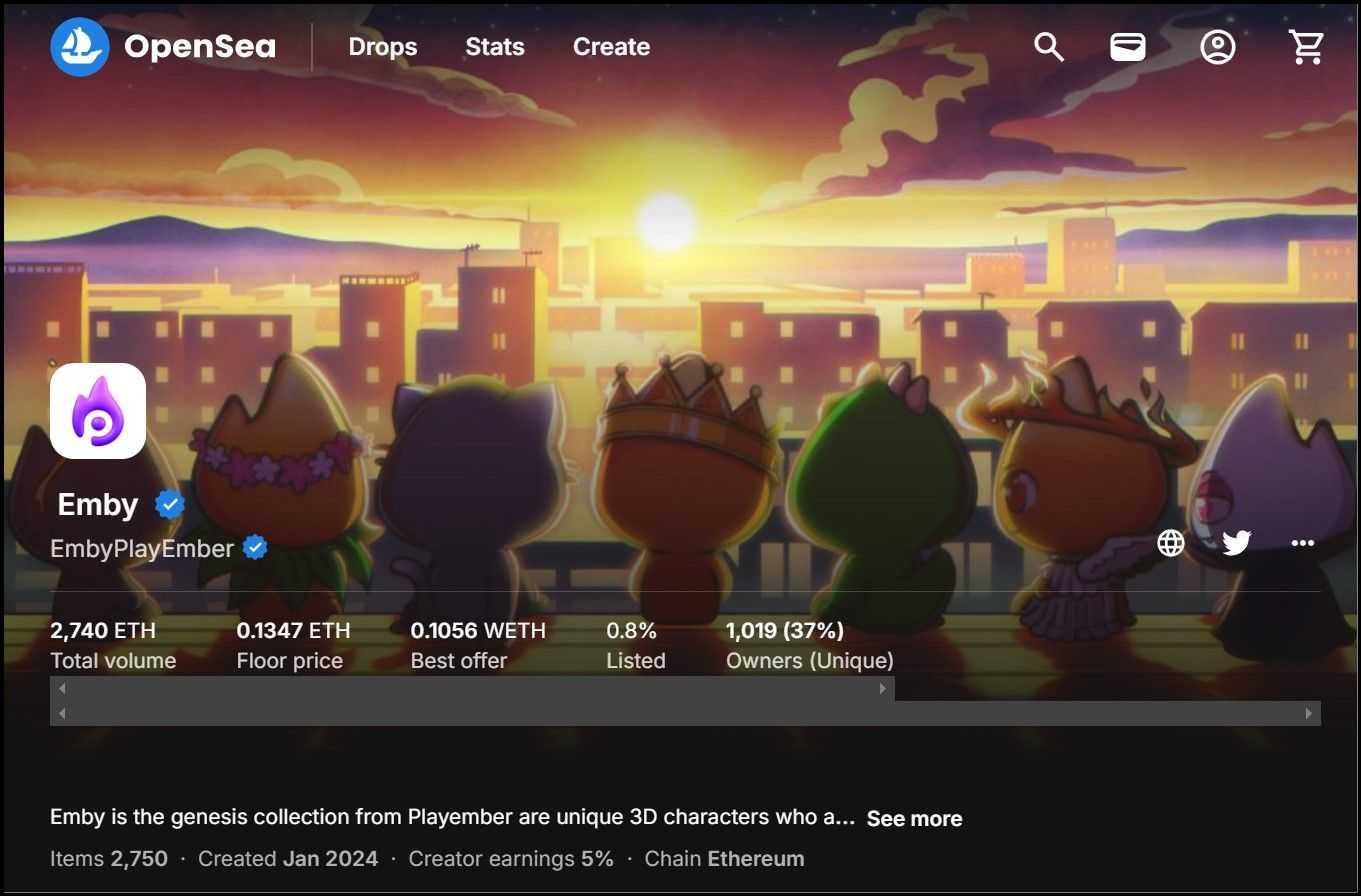
PlayEmber’s ecosystem includes the Emby NFT collection, which enhances the gaming experience by serving as a player’s companion across multiple games. Additionally, the studio has introduced SPRK tokens within their mobile games, allowing users to earn in-game rewards with potential broader uses in the future.
Where to Buy NEAR?
As NEAR is one of the most popular coins, the NEAR Coin is available on most major exchanges. For international users, I recommend Binance or OKX. US-based users can buy NEAR on Kraken and Coinbase. I normally recommend Kraken to US-based users because of the lower fees, better customer service, and advanced features.
You can learn more about these exchanges in our following reviews:
Where to Store NEAR?
To store your NEAR tokens, there are several wallet options, each suited for different use cases:
- NEAR Mobile Wallet: Official wallet for NEAR, offering token management, staking, and easy integration with DApps.
- MetaMask: Popular Ethereum wallet, now supporting NEAR through "Snaps." Ideal for users involved in multiple blockchain ecosystems.
- Trust Wallet: Mobile wallet supporting NEAR with staking features. Known for its security and open-source code.
- Ledger Wallets: Hardware wallets like Ledger Nano S/X, offering top-level security through cold storage.
- Sender Wallet: Non-custodial, supports staking, NFTs, and DApp interaction with a focus on customizability.
- Meteor Wallet: Non-custodial, gamified wallet with cross-platform access and support for DeFi services.
- HOT Wallet: A new wallet in the NEAR network that is gaining traction recently and can be an ideal choice for storing NEAR tokens.
- MyNearWallet: The best option for maximum ecosystem compatibility.
You can find out more in our best NEAR wallets article.
Top NEAR Projects: Conclusion
I hope you found this article helpful in providing insight into what is thriving in the ecosystem.
NEAR is an incredibly advanced, bustling network with plenty of users and developers and is rapidly growing in size. The NEAR ecosystem supports everything from DeFi to NFT projects, stablecoins to GameFi, and everything in between, hosting exciting crypto projects.
Many users are highly bullish on the protocol's future as it has an impressively high throughput and TPS, nearly instant finality, and is theoretically infinitely scalable, an exceptional boast that other layer one blockchain cannot claim.
Frequently Asked Questions
NEAR is an open-source software framework that allows for the use of web3 applications. The network uses a proof-of-stake consensus mechanism and the Nightshade sharding introduction enables security and scalability. The network is capable of hosting an entire DeFi ecosystem with different DApps and cryptocurrencies, fulfilling multiple real-world use cases.
For a software non custodial wallet, I recommend NEAR Wallet, which was created by the Near Foundation, or MyNearWallet is also very popular. Users who want to increase their security will be pleased to learn that the Ledger Hardware wallet supports the Near Coin.
Users can also create a Near wallet on Metamask by simply adding the Near network.
The most common Near blockchain explorer is explorer.near.org
The most popular NFT market for NEAR is Paras. The Paras marketplace has thousands of unique digital assets available for users of varying tastes from digital art cards and collectibles, to GameFi and utility NFT projects.
The term Near token and Near coin are often used synonymously, but consensus among the community in the crypto space is that there is a distinction. A token is an asset minted on a blockchain, while a coin is the network's native token, often used to cover gas fees. So it should be Near Coin and not Near token.
Disclaimer: These are the writer’s opinions and should not be considered investment advice. Readers should do their own research.


